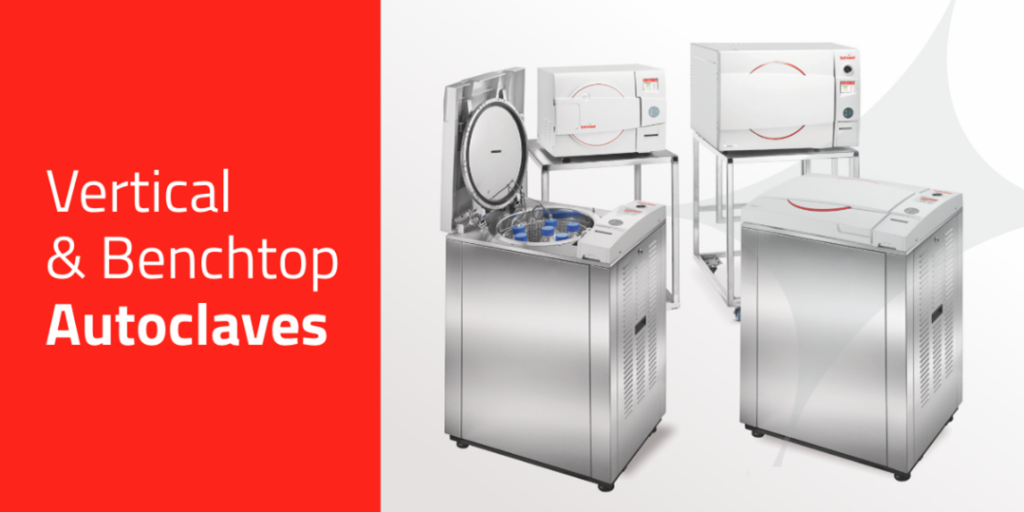By Ad Geilings, Global Product Manager Laboratory
There are three technological processes associated with autoclaving material and are based on the following elements: gravity, pre-vacuum, and isothermal.
| Gravity | The most basic sterilization cycle. Steam displaces air in the chamber by gravity. The gravity design is utilized for sterilizing non-porous heat and moisture stabilized goods. These include liquids and media and solids such as laboratory waste. | Glassware, unwrapped goods, waste, utensils |
| Pre-Vacuum and/or Post Vacuum | Air is mechanically removed from the chamber and load through a series of vacuum and pressure pulses. This allows the steam to penetrate porous areas of the load that couldn’t otherwise be reached with simple gravity displacement. The pre vacuum increases the speed and efficiency associated with sterilization. It expands the capability of the gravity design by its ability to sterilize porous heat and moisture stable materials | Wrapped goods, animal cages, porous materials |
| Isothermal | This cycle addressed the need to sterilize at lower temperatures for the heat sensitive and heat coagulable material. The isothermal process is usually used for pasteurization, inspissation agar sterilization | Infant formula, agar, media |
Each process has a variety of cycles that may be employed and are dependent upon the process, or options associated with each autoclave. These include: heat, gravity, pre-vacuum, sterilize, exhaust and dry. Exhaust may either be undertaken rapidly or slowly. The rate of exhaust will depend upon the nature of the load. Dry material will permit a fast exhaust, while liquids require slow exhaust to prevent boiling over of super-heated liquids. Refer to the autoclave manual to obtain a complete description of the cycles available.
Some autoclaves also have the ability to perform special cycles designed to avoid damage to delicate goods that need to be sterilized but would be damaged or destroyed by the rapid changes in temperature and pressure in a normal cycle. These special cycles include much longer cycles at lower temperatures, steam-air mix cycles with special pressure controls to avoid breaking sealed test tubes, and cycles that use special instrumentation to ensure full sterilization temperature is achieved.
When is it ideal to use an Isothermal or Low Temperature Cycle?
When the objects are not heat-stable, prone to congeal, or do not reach temperatures higher than atmospheric steam. For example,
- Thermoplastics, like LDPE
- Sensitive liquids, like milk or baby formula
- Some medical devices
- Media and agar preparation, as this cycle allows for the media (agar) to melt without overheating it.
Various Tuttnauer laboratory vertical and horizontal autoclaves offer advanced cycle programs, including the media processing cycles: For preparing agar and other biological media with a temperature range from 60°C to 95°C that allows for gentle heating and cooling down of agar.
To learn more visit https://tuttnauer.com/laboratory-autoclaves

What is the isothermal (Agar) process?
An isothermal process is a thermodynamic process in which the temperature of a system remains constant. The transfer of heat into or out of the system happens so slowly that thermal equilibrium is maintained.
The most effective and suitable method of sterilizing agar is by using moist heat in the form of steam under pressure i.e. 121°C for 15 minutes at 15 pounds per square inch (psi). This method will denature & coagulate enzymes and other cell constituents in the bacterial cell.

Optional isothermal cycles are typically used for preparing agar and other biological media. Tuttnauer offers a flexible isothermal cycle with a temperature range from 60°C to 95°C that allows for gentle heating and cooling down of agar.
The isothermal process is usually used for pasteurization, inspissation, or fractional (intermittent) sterilization. Each process has a variety of cycles that may be applied and are dependent upon the process parameters, or options associated with each autoclave.
About the author
Ad Geilings, Global Product Manager Laboratory
Ad has been working for Tuttnauer Europe from 1997 until 2001 as Technical Manager, he has been in senior roles as Managing Director Tuttnauer Europe for 20 years. As a global product manager Ad works very closely with the engineering and R&D team. Ad has been a member of Dutch Committee Sterilization & Sterility since 1997.


